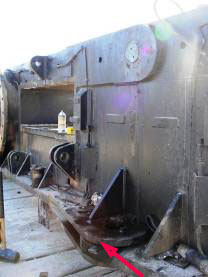Lacerated chin caused by flying wedge
An incident has been bought to the attention of IMCA, in which a worker received a laceration to the chin. A worker was removing a steel wedge from the frame of a crane track during disassembly. The wedge dislodged when struck by a sledge hammer and ricocheted against the frame before striking the worker. The worker was taken to an offsite facility for treatment where he received stitches. He was able to return to work without restrictions.
Investigation revealed the following:
- The wedge was in a bind when it was struck;
- The injured person was ‘in line of fire’ for the rebound of the wedge after it was struck by the sledge hammer;
- The injured person was not wearing a face shield whilst removing the wedge;
- Established procedures did not adequately recognise or cover the hazards for the task being performed.
The following lessons were noted:
- The use of wedges for this process should be eliminated and the appropriate alternative tools used for pin alignment and removal;
- Appropriate personal protective equipment (PPE) including face shields should be used for required wedge hammering, impacting and banding operations;
- More detailed work plans were developed down to the task level, including specific PPE for each task, appropriate tools and body positioning.

Safety Event
Published: 15 December 2010
Download: IMCA SF 08/10
IMCA Safety Flashes
Submit a Report
IMCA Safety Flashes summarise key safety matters and incidents, allowing lessons to be more easily learnt for the benefit of all. The effectiveness of the IMCA Safety Flash system depends on Members sharing information and so avoiding repeat incidents. Please consider adding safetyreports@imca-int.com to your internal distribution list for safety alerts or manually submitting information on incidents you consider may be relevant. All information is anonymised or sanitised, as appropriate.
IMCA’s store terms and conditions (https://www.imca-int.com/legal-notices/terms/) apply to all downloads from IMCA’s website, including this document.
IMCA makes every effort to ensure the accuracy and reliability of the data contained in the documents it publishes, but IMCA shall not be liable for any guidance and/or recommendation and/or statement herein contained. The information contained in this document does not fulfil or replace any individual’s or Member's legal, regulatory or other duties or obligations in respect of their operations. Individuals and Members remain solely responsible for the safe, lawful and proper conduct of their operations.
